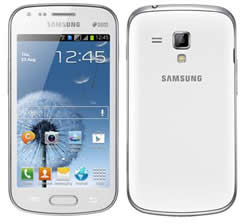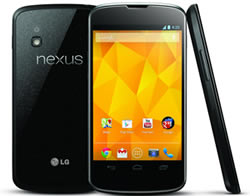Difference between Samsung Galaxy S Duos and Nexus 4
Key difference: Samsung Galaxy S Duos is a dual-SIM phone that was launched in September 2012. The phone comes with a 4-inch TFT capacitive touchscreen, with approximately 233 ppi density. The device comes with Samsung’s TouchWiz UI on Android 4.0.4 ICS. The Nexus 4 is Google's fourth Nexus-branded Android smartphone. It was produced in collaboration with LG Electronics. The phone runs on the Android 4.2 (Jelly Bean) operating system, which was launched with the phone.

Initially smartphones would come in two categories, the no-nonsense simple phone and the extravagant phone with loads of features and a high price tag. However, now there are many people who expect different things from their phone, including features but a lesser price tag, durability, more battery power, etc. This has enabled smartphone manufacturers to offer an array of different phones for the different types of customers. Samsung announced the Galaxy S Duos as an option aimed for people that require double SIM capability, eliminating the need for carrying two separate phones. The phone was launched in September 2012.
At first glance, the Samsung Galaxy S Duos bears heavy resemblance to the company’s flagship phone, the Samsung Galaxy S3. However, looking past the basic form of the phone and picking it up; the user can realize the reason for such a small price tag. The phone is a cheaper version of its big brother, with a lesser quality plastic and some downgraded features. However, let’s not label it as of yet, as it does come with some good specs. The 4-inch TFT capacitive touchscreen, with approximately 233 ppi density, is pretty decent with good contrast and colors but it is too reflective under sunlight, making it a bit difficult to use outdoors without squinting or trying to cover the screen.
The phone itself is easy to hold and handle, making it sleek and small enough to slip into jeans pockets or a small purse when on the go. The 120 grams of weight also ensures that the phone does put that much pressure on the hands when holding the device for longer periods of time. The top of the device houses only the 3.55 mm jack, while the bottom only has the USB/charging port. The right side of the device holds the power button on the top right hand and the microSD card slot. The left side of the device only holds the volume rocker, a bit hard to reach, if a person is used to having it on the right. On the front, the device has the home button that is surrounded by capacitive more options and a back button.
The device comes with Samsung’s TouchWiz UI on Android 4.0.4 ICS. Again, the UI is a toned down version of the one found on the S3. The device lacks the ripples effect and the water-drop sound and has four customizable shortcut buttons on the bottom of the lockscreen that can directly take you to apps such as missed phone calls when unlocking the device. The device allows users to add/remove apps from the homescreen as well as add/remove panels similar to other versions of Android.
The device is powered by a 1 GHz Cortex-A5, with about 786 MB of RAM. The RAM is a slight upgrade to the 512 MB available on other phones, but it still isn’t that great when trying to run dual-SIM, resulting in some lagging during operation. The dual-SIM capability and standby allows both SIMs to be operational at the same time. The device comes with a 5 MP rear camera for taking photos and recording videos. The rear camera is pretty decent in terms of taking photos. The images have pleasing colors and a good dynamic range, but the photos are a bit grainy. The phone also comes with features such as smile detection, geo-tagging, Share shot, effects and panorama mode. The S Duos also houses a VGA (0.3 MP) front camera that is as okay, nothing much to talk about. The phone can also capture videos in VGA resolution at 30fps.
The S Duos comes with a decent removable LI-Ion 1500 mAh battery, that according to the company provides a talk time of 770 minutes in 2G and 520 minutes in 3G, along with a standby time of 570 hours in 2G and 470 hours in 3G. The phone does not come with the same amount of features as available in Galaxy S3, but with the price tag of this device, it is still something. The main reason for purchasing the phone would still be the dual-SIM capability, while in other countries where dual-SIM options are more common, the phone may not fare as well.
 A number of these companies’ smartphones and tablets run on Android. Android is an open source software, which means that the code is freely available for modification and distribution by device manufacturers, wireless carriers and enthusiast developers. Among the number of various companies, Google has also launched its own line of smartphones based on Android, called the Google Nexus. Each device in the Nexus line is produced via collaboration between Google and a leading original equipment manufacturer (OEM) partner.
A number of these companies’ smartphones and tablets run on Android. Android is an open source software, which means that the code is freely available for modification and distribution by device manufacturers, wireless carriers and enthusiast developers. Among the number of various companies, Google has also launched its own line of smartphones based on Android, called the Google Nexus. Each device in the Nexus line is produced via collaboration between Google and a leading original equipment manufacturer (OEM) partner.
The Nexus devices in general have an advantage over other devices in that the Android in the Nexus devices is pure, i.e. the Android does not have any manufacturer or wireless carrier modifications to it, such as a custom graphical user interface. The Android also has an unlockable bootloader to allow further development and end-user modification, all of which is usually blocked on other Android smartphones.
The Nexus 4 is Google's fourth Nexus-branded Android smartphone. It was produced in collaboration with LG Electronics. The phone features a 1.5 GHz quad-core Snapdragon S4 Pro processor, 2 GB of RAM, 8 or 16 GB of internal storage, front facing 1.3 megapixel camera and an 8 megapixel rear camera and a micro-SIM card tray. The phone runs on the Android 4.2 (Jelly Bean) operating system, which was launched with the phone. The phone also features a new camera technology, called the Photo Sphere. This allows one to take 360 deg Panorama shots.
The information for the detailed table about the two devices has been taken from Samsung website, Google website, knowyourmobile.com and GSMArena.com
|
|
Samsung Galaxy S Duos |
Nexus 4 |
|
Launch Date |
September 2012 |
November 2012 |
|
Company |
Samsung |
Google; designed in collaboration with and manufactured by LG Electronics. |
|
Size |
121.5 x 63.1 x 10.5 mm |
133.9 x 68.7 x 9.1 mm (5.27 x 2.70 x 0.36 in) |
|
Display |
4.0-inch TFT capacitive touchscreen |
4.7 inches True HD IPS Plus capacitive touchscreen, |
|
Screen |
480 x 800 pixels (~233 ppi pixel density) 16M colors |
768 x 1280 pixels, (~318 ppi pixel density) 16M colors |
|
Protection |
No |
Corning Gorilla Glass 2 |
|
Weight |
120 grams |
139g (4.90 oz) |
|
2G Network |
GSM 850 / 900 / 1800 / 1900 - SIM 1 & SIM 2 |
GSM 850 / 900 / 1800 / 1900 |
|
3G Network |
HSDPA 900 / 2100 - SIM 1 & SIM 2 |
HSDPA 850 / 900 / 1700 / 1900 / 2100 |
|
4G Network |
N/A |
No |
|
GUI |
TouchWiz 4.0 UI |
Pure Android |
|
CPU speed |
1 GHz Cortex-A5 |
Quad-core 1.5 GHz Krait |
|
GPU |
Adreno 200 |
Adreno 320 |
|
OS |
Android OS v4.0 (Ice Cream Sandwich) |
Android OS, v4.2 (Jelly Bean), upgradable to v4.2.2 (Jelly Bean) |
|
Chipset |
Qualcomm MSM7227A Snapdragon |
Qualcomm APQ8064 Snapdragon |
|
RAM |
768 MB |
2 GB RAM |
|
SIM Size |
miniSIM (Dual-SIM handset) |
microSIM |
|
Internal Memory |
4 GB (1.8 GB available to the user) |
8/16 GB storage |
|
Expandable Memory |
Up to 32 GB |
No |
|
Sensors |
Accelerometer, Geo-magnetic, Proximity Sensor |
Accelerometer, gyro, proximity, compass, barometer |
|
Connectivity |
GSM; EDGE/GPRS (850/900/1,800/1,900MHz); HSDPA 7.2; Wi-Fi 802.11b/g/n 2.4GHz; Wi-Fi Direct; Bluetooth |
WiFi 802.11 a/b/g/n, Bluetooth, NFC (Android Beam), Unlocked GSM/UMTS/HSPA+, GSM/EDGE/GPRS, 3G, HSPA+ 42, Wireless charging, SlimPort (TM) |
|
Data |
GPRS, EDGE, WLAN, Bluetooth, USB. |
WiFi, NFC, GPRS, EDGE, USB |
|
Speed |
HSDPA, 7.2 Mbps; HSUPA, 5.76 Mbps |
DC-HSDPA, 42 Mbps; HSDPA, 21 Mbps; HSUPA, 5.76 Mbps |
|
WLAN |
Wi-Fi 802.11 b/g/n, Wi-Fi hotspot |
Wi-Fi 802.11 a/b/g/n, dual-band, DLNA, Wi-Fi hotspot |
|
Bluetooth |
Bluetooth v3.0 with A2DP |
Bluetooth v4.0 with A2DP |
|
USB |
microUSB v2.0 |
microUSB (SlimPort) v2.0 |
|
Primary Camera |
5 MP CMOS rear camera |
8 MP, 3264 x 2448 pixels, autofocus, LED flash, check quality |
|
Secondary Camera |
VGA CMOS front camera |
1.3 MP |
|
Video |
VGA@30fps |
1080p@30fps |
|
Camera Features |
|
|
|
Sound Enhancement |
No |
SNS integration Active noise cancellation with dedicated mic |
|
Audio supported formats |
AAC, AAC+, AMR, AMR-NB, AMR-WB, eAAC+, I-Melody, IMY, M4A, MIDI, MP3, OGG, SP-Midi, WAV, WMA |
MP3/WAV/eAAC+/AC3 player |
|
Video supported formats |
MPEG4, H.263, H.264 |
MP4/H.264/H.263 player |
|
Battery Capacity |
Removable Li-Ion 1500 mAh battery |
2100 mAh battery |
|
Talk time |
2G: 770 minutes 3G: 520 minutes |
No official data released |
|
Stand-by |
2G: 570 hours 3G: 470 hours |
No official data released |
|
Available Colors |
White, Black, La Fleur |
Black |
|
Messaging |
SMS (threaded view), MMS, Email, Push Email |
SMS(threaded view), MMS, Email, Push Mail, IM, RSS |
|
Browser |
HTML, Adobe Flash Lite |
HTML5 |
|
Radio |
Stereo FM radio with RDS |
No |
|
GPS |
GPS with A-GPS support |
A-GPS support and GLONASS |
|
Java |
Java via Java MIDP emulator |
Java MIDP emulator |
|
Additional Features |
|
|
Image Courtesy: samsung.com, battellemedia.com









Add new comment